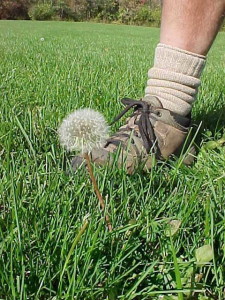The thing about spring greens is that you have to catch them early. Before the flowers arrive. Once you see the flowers or the seeds, it’s too late–all that tender sweetness is gone, like bolted lettuce. As the plant flowers, the leaves change from a tasty, crunchy mouthful to a bitter pill to swallow.
This makes perfect sense, from a plant’s point of view. Once the plant is putting energy into reproduction, creating the flowers which will become the seeds of the next generation, the plant is “anxious” to keep from being nibbled by any organism, be it insect, deer, rabbit, or human. The plant creates ill-tasting, bitter chemicals that help fend off hungry herbivores.
Now mind, you, greens are still good for you, even after they become bitter. Remember the prophecy (threat? promise?) of the Old Testament: “They shall eat bitter herbs.”
There’s value in bitterness: a difficult lesson to learn. Just because something tastes bitter doesn’t mean it’s bad for us. Sweet is what humans crave, from the first sweet taste of breast milk; we are born with a sweet tooth. It seems to be against our pleasure-loving nature to eat that which is bitter. So as early humans developed agriculture, at harvest-time they carefully chose which seeds to sow in spring, and they selected the tenderest, juiciest, and above all the sweetest fruits and grains. To this day, when horticulturists are deciding what varieties of tomatoes or lettuce to propagate, they tend to throw away the bitter and choose the sweet.
But the worldly-wise prophets of the Old Testament had seen a thing or two, and they knew that life isn’t always sweet. The bitterness in plants is caused by phytochemicals that are richly health-giving. Iceberg lettuce is sweet, or rather, bland–and it’s blandness that is the direct opposite of bitterness.
Wild spring greens have a tangy, bold taste: plantain, violet leaves, clover, dandelion, ground ivy. They’re strong-flavored, for sure–I like to blend them with some store-bought lettuce to soften their punch. But all are delicious and safe to eat.
But for the true gourmet flavor of wild spring greens, get’em while they’re young. Once you see that yellow blossom, the dandelions are over the hill. 





We are often admonished that one has to “take the bitter with the sweet”. I like a little bitter taste in my greens. What is ” bitter” to one person may just be tangy or have a “bite” to another person. Thanks for the reminder that bitter is not bad.